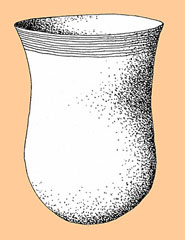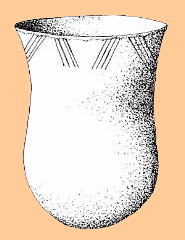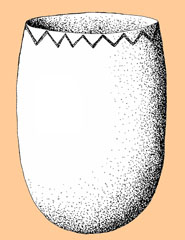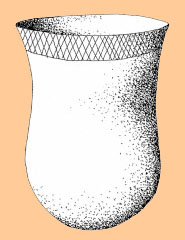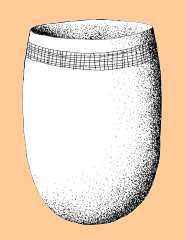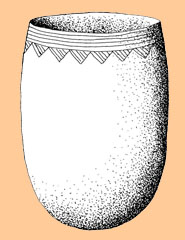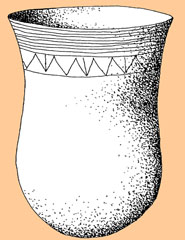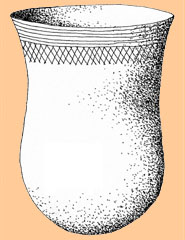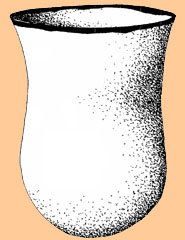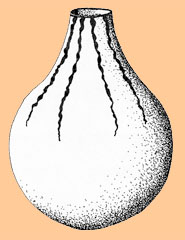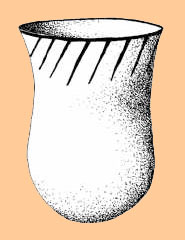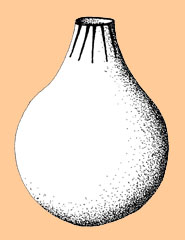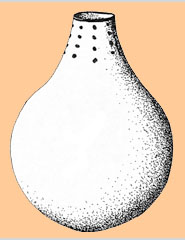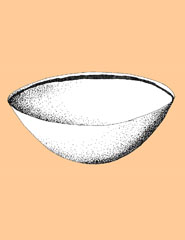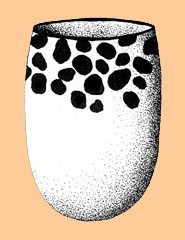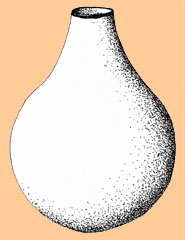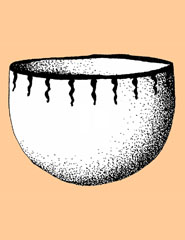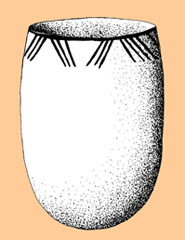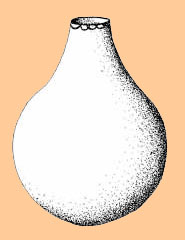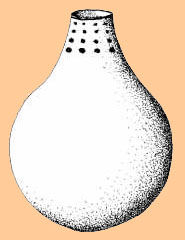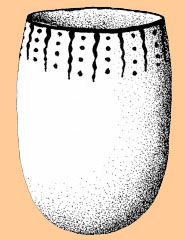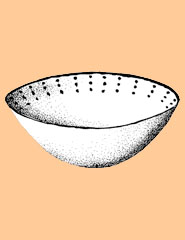Rockport Pottery Decorative Motifs
The very large collection of Rockport pottery from the Guadalupe Bay site allowed for the recognition of 22 decorative motifs composed of various design elements. Such design elements represent the basic incised or painted patterns that the aboriginal potters used to create the overall decorative motifs that embellished their vessels. If a motif was relatively simple, then usually only one design element was involved. However, if a motif was more complicated, then two or more design elements were brought together to create the motif. Identification of motifs and design elements was done to create an interpretive framework that, hopefully, will allow current and future researchers to detect decoration differences within the Rockport pottery tradition as it developed over the course of approximately 550 years from A.D. 1150 to 1700.
At present, there are eight motifs recognized for Rockport Incised, seven motifs for Rockport Black, and seven motifs for Rockport Black-on-gray. The images shown below are idealized reconstructions showing how the designs would have appeared on intact vessels. Each image is linked to an enlargement and discussion of the defining details for each motif. Below the gallery images readers can learn more about the decorative motifs and design elements.
Rockport Incised
Rockport Black
Rockport Black-on-gray
Decorative Design Elements
The bulk of decorated Guadalupe Bay pottery falls into two broad categories: intentionally painted decoration (including Rockport Black-on-gray and Rockport Black), and incised decoration (Rockport and Goose Creek Incised). Two other minor categories, overall red filming (Rockport Red) and polychrome painting (Rockport Polychrome), were recognized. These, however, were not further characterized as they either lacked variation in decorative design or were very few in number. The remaining decorated sherds initially were separated by type and variety, and then each was given an alpha-numeric code that described the specific basic decoration present, termed a “design element,” to better define recurring patterns.
Incised sherds exhibited 15 design elements: (1) vertical straight lines, (2) horizontal straight lines, (3) diagonal straight lines, (4) curved lines, (5) perpendicular straight lines, (6) parallel straight lines, (7) horizontal zigzag lines, (8) diagonal overincised lines, (9) vertical overincised lines, (10) crosshatched overincised lines, (11) chevron pattern, (12) open triangles, (13) line-filled triangles, (14) crosshatched lines, and (15) crossed lines. A sixteenth category, “unknown line orientation,” also was set up for those incised lines that could not be placed in one of the primary groups.
Painted sherds (both with and without gray slip) exhibited 14 design elements: (1) vertical straight lines, (2) vertical wavy lines, (3) horizontal straight lines, (4) horizontal wavy lines, (5) diagonal straight lines, (6) pendant loops, (7) curved lines, (8) perpendicular lines, (9) lines of unknown orientation, (10) dots, (11) open circles, (12) triangles, (13) random dabbing (splotching that resembles blobs made by dabbing the vessel with asphaltum paint), and (14) swastika.
Each of the design elements was subdivided further by the width of the lines forming the element. The widths of dots and dabbed areas also were recorded when appropriate. Lines and/or dots and dabbed areas less than 2 mm across were considered “narrow.” Those between 2 and 4 mm were considered “medium,” while those greater than 4 mm were “wide.”
Decorative Motifs
Once all excavated sherds were examined for the presence of one or more design elements, it was possible to recognize recurring decorative patterns or motifs that form the highest order of decorative intent on the part of the aboriginal potters at Guadalupe Bay. Such motifs consisted of single design elements if the motif was relatively simple, or multiple design elements if it was slightly more complicated. At present, there are eight motifs recognized for Rockport Incised, seven motifs for Rockport Black, and seven motifs for Rockport Black-on-gray. The above gallery illustrates these 22 motif patterns and provides discussions of each.
Since the current type-variety system of ceramic classification was developed as a means of recognizing the paste characteristics of Rockport ceramics, it could not be used for motif classification, although that generally is how the type-variety system is employed elsewhere in the Southeast and Lower Mississippi Valley. For that reason, a slightly modified version of the type-variety system was employed for motif classification for the Guadalupe Bay pottery.
Motifs are given names, like varieties, but such names are enclosed in quotation marks and followed by the word “motif,” whereas variety names are italicized and preceded by the abbreviation “var.” Thus, a motif is written as Rockport Incised, “Ayres Point" motif, while a variety is written as Rockport Incised, var. Mustang Lake. By providing motifs with names, it will be possible in the future to simply incorporate these names into the type-variety system if it later is decided to eliminate the current paste-oriented type-variety system and to establish a more conventional, decoration-oriented type-variety system. For now, the two systems run parallel to each other and together allow for Rockport ceramics to be discussed by both paste and decoration.
Rockport Incised Motifs
Eight motifs were recognized for Rockport Incised, based on a total of 85 sherds that were sufficiently large enough to allow for motif identification. Although Rockport Incised sherds made up only a modest portion of the total ceramic assemblage at Guadalupe Bay, a reasonably large number of the specimens were recognizable to motif. Since Rockport Incised designs are almost always confined to the rim and/or upper portion of the vessel, it is possible to find individual rim sherds that contain a major portion of the overall decorative motif. This, in turn, leads to greater certainty on the part of the analyst as to which motif actually is represented. Painted vessels, on the other hand, usually employed designs that included portions of the lip, neck, and body of the vessel. Although the lip area usually was entirely painted, decoration on the neck and body portions of the vessel often was less inclusive (i.e., individual wavy lines, isolated dots, dabs, etc.), leaving relatively large, intervening, nondecorated areas. Therefore, the chance of finding groups of associated design elements on individual body sherds, even when examining thousands of examples from painted vessels, is extremely small. All Rockport Incised motifs were named after geographic “points” identified on various topographic maps of the area.
Rockport Black Motifs
Seven motifs were recognized for Rockport Black. Some are similar to those noted below for Rockport Black-on-gray, although there are several differences that may prove meaningful in the future. On the contrary, it may later be found, with greater recognition of motifs from other sites, that there are no differences between the painted wares, and a single set of motif names could be used to cover both Rockport Black and Rockport Black-on-gray designs. It also should be noted that several of the motifs are based on small sherds making establishment of the motifs somewhat tentative. It is hoped, however, that future studies either will confirm or reject the legitimacy of these motifs. Motifs of Rockport Black are all named after “bays” appearing on topographic maps of the region.
It should be noted that sherds exhibiting only painted bands around the lip were, by definition, classified either as Rockport Black or Rockport Black-on-gray. As such, these sherds formed a large percentage of all decorated designs of these two types. Earlier investigators also had noted the same preponderance of black-banded rims and Ricklis even defined banded rims as a separate type that he labeled “Rockport Black-on-gray I.” Since only small rim sherds are present in the current collection, as opposed to whole vessels or relatively large rims, it is impossible to determine if the painted band occurs alone, and, thus, is the only decoration on the vessel, or if it actually is associated with other decorative elements.
For that reason, there was some hesitation at first to setting up black banding as a decorative motif. Ignoring black banding, however, would have eliminated one of the most potentially prominent forms of Rockport decoration from the list of recognized motifs. As past studies have shown that vessels with only black banding do indeed exist, the decision was made to identify rim sherds with black banding as a specific motif. It should be understood, however, that many of these sherds might actually be from vessels with some form of body decoration. Until an adequate sample of whole vessels or relatively large rim sherds is examined, it is impossible to know the percentage of vessels in a Rockport ceramic assemblage that contain only black-banded rims.
Rockport Black-on-gray Motifs
As with Rockport Black, there are seven motifs recognized for Rockport Black-on-gray. Four are equivalent to motifs found on Rockport Black, but three represent different decorative ideas. Rockport Black-on-gray motifs are named after “islands” illustrated on the area’s topographic maps.
